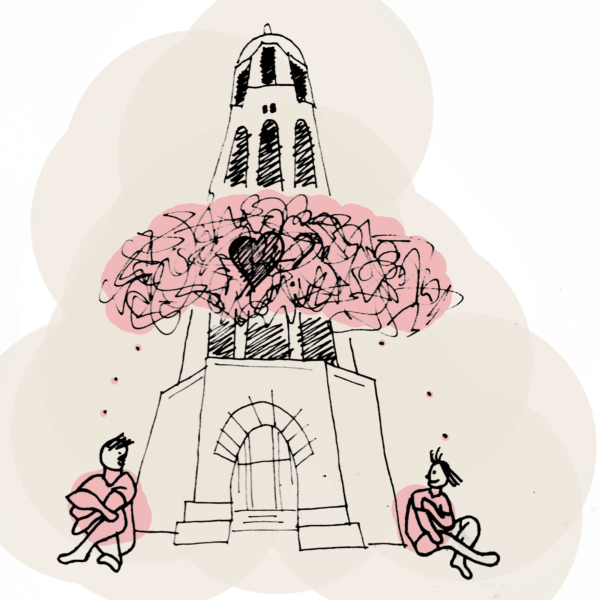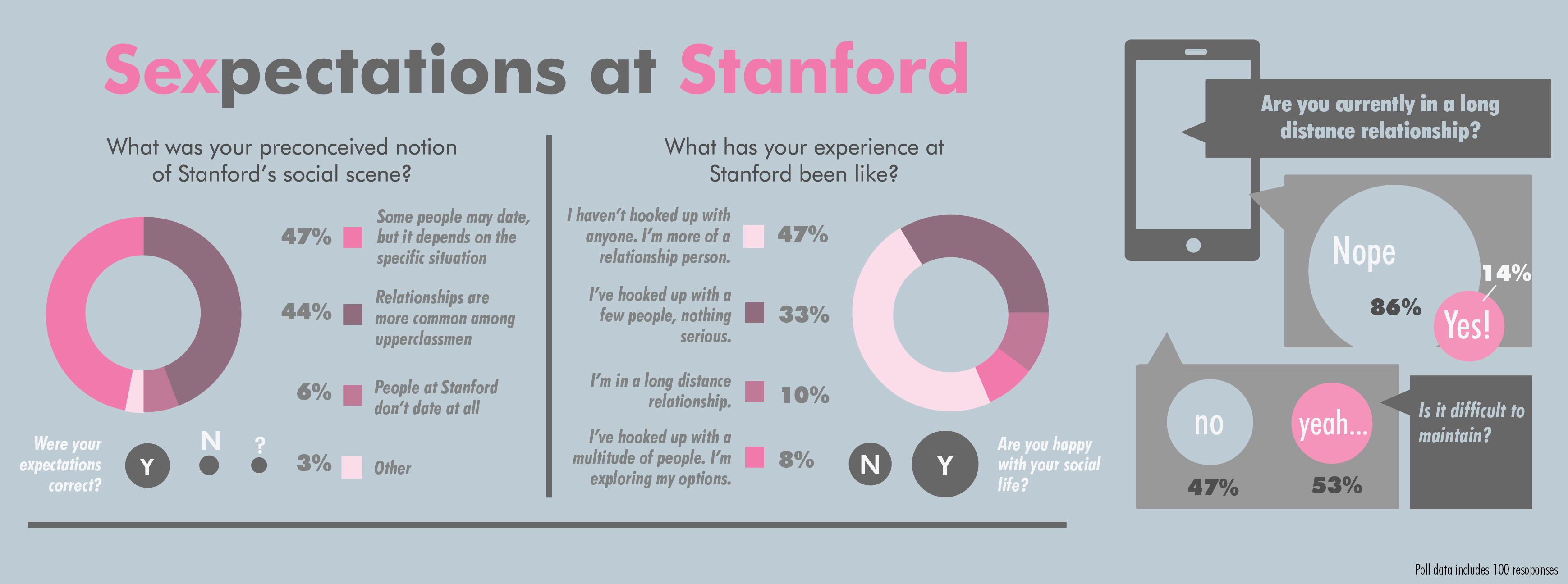
After my boyfriend and I separated at the end of the summer, my friend emailed me an article about Stanford’s social scene and wrote two words in the subject line: Good luck. After scanning the article, I sat in my bedroom and decided that I’d keep an open mind.
I was considered a prude in high school. How I developed that particular label, I’m not entirely sure, but it may have stemmed from my lack of interaction with the opposite gender. Growing up, I had no guy friends and no brothers. I was already shy enough around girls my age, so talking to a boy was impossible. I didn’t start dating until the end of senior year, and the guy I dated had known me for years prior. To put it simply, I had no real experience with boys.
Stanford’s reputation for being a non-dating campus with a rampant hookup culture honestly scared me. I hardly knew what it meant to be in a relationship, so the thought of hooking up sent my head spinning. The phrase “hooking up” seems to be indefinable.
When asked how she would describe it, one freshman replied, “I’m not really sure. It’s beyond confusing because it could mean anything from just making out to having sex.”
I’ve even heard numerous adults use it as a synonym for meeting up. I cringe every time.
With an amorphous definition established, I decided to post a short survey in the Class of 2020 Facebook group. Of 100 freshmen who took it, only six shared my rather black-and-white belief that Stanford students don’t date at all. Most students believed that relationships are more common among upperclassmen. The rest agreed that it depends on the specific situation and that dating is possible in any year.

From junior Evan Long’s ‘18 perspective, there is “a [general] shift away from [hookup culture] beginning late in freshman year and ending in the middle of sophomore year.”
For the 47 surveyed students who haven’t hooked up with anyone, there is hope for a relationship. Combined with partying and alcohol, many freshmen are in an exploratory state. While new experiences are exciting, some students may find themselves bored of hookups and begin looking for deeper relationships.
“The initial social scene was crazy,” one male freshman stated, “and a lot of people tried things they normally wouldn’t do. I think people are now starting to choose relationships over hookups.”
Whether the craze slows down after freshman fall quarter or after sophomore year, hookups will always have a place in Stanford’s social scene, as with many universities. The appeal of no strings attached combined with physical pleasure is alluring. While some students believe hookups may not be the best way to have fun without commitment, they push people past their comfort zones. In every aspect, Stanford is a place where students are forced to break down barriers, dabble in an array of unexplored studies and communicate honestly with peers and instructors.
While freshman Paco Lopez ‘20 believes that hooking up allows “everyone to be more honest and straightforward with their desires,” he is not part of the scene. Currently in a long-distance relationship (LDR), Lopez has had a very different experience than many on campus. From the survey, only 14 percent of students consider themselves to be in a LDR. Already in a committed relationship for more than a year, Lopez found navigating parties with friends to be difficult. While his friends hunted for hookups, he couldn’t relate.
Freshman Andrew Gonzalez ‘20 has two LDRs under his belt, one from high school and one currently. Even though he has prior experience, Gonzalez still finds maintaining a technology-based relationship very difficult. He agreed it is an extremely rewarding experience, but often, one factor breaks an LDR: physical presence.
“The difficult part [of being in an LDR] is not getting mad or petty with each other. You seem to be more short-tempered the further away you are, and texting doesn’t convey emotions well,” Gomez said.
Although web-based contact poses quite the challenge, Gonzalez believes it helps partners grow closer. “Asking random questions all day long helps you understand your partner in ways you can’t imagine,” he stated. Knowing a partner’s likes and dislikes makes it easier to send funny GIFs, surprise presents and handwritten notes.
Agreeing with Gonzalez, Gomez noted, “It’s immensely rewarding to see little glimpses into your loved one’s life, but it’s difficult too because you can’t get more involved.” Both boys recognized miscommunication as a potential cause for a relationship ending (especially during first quarter, with acclimation to the college life), but they said this should not deter a couple from trying one out.
In the article emailed to me, I read about the struggle of making LDRs last until Thanksgiving. As Long calls it, “Breaksgiving” is a sad week in November dedicated to figuring out a rocky relationship.
“A number of my friends began Stanford in long-distance relationships. Most of them ended by Breaksgiving, but the ones that survived fall quarter usually lasted significantly longer,” Long said.
Unlike Gomez and Gonzalez, one female freshman has an alternative perspective when it comes to LDRs. Having met her significant other only a few months before leaving for Stanford, they vowed to make it work as best as possible. In the beginning, daily text messages and FaceTime chats were enough to fill the void in her heart. As the quarter continued, she realized the bleak reality of being able to make it work in the long term.
“Long-distance is so difficult. Even if you really love them, it’s just hard to grasp that committing to the relationship through college means four years of not being together,” she contended. “My mentality has changed to think that I might as well make myself as happy as I can in the moment, instead of holding out for the future.”
For others in the same position, she advises talking about your significant other to friends or peers. Making them come alive through description is sometimes the only way to feel close to them while simultaneously validating how much they mean to you.
“As for Thanksgiving break, it’s the first time that you’re encountering your old life again. It’s the first time you can directly compare your old life with the new,” she commented.
If you’re unsure of the pros and cons of each type of social situation, consider Gomez’s advice: “Look for someone who makes you smile.” No matter your style of meeting people or maintaining a relationship, you should be happy, and many people are. Seventy-one of 100 surveyed students considered themselves happy with their current social lives. For the 29 who answered negatively, I can relate.
If you’re wondering, I kept my promise to stay open-minded. During the first half of the quarter, I had my small share of casual flings. They were flexible, easy and only lasted about a week. While I enjoyed the initial thrill, I realized they lacked the emotional connection I needed. The same friend who sent me the first article also emailed me another article with the subject line It’s okay.
Entitled “How I Realized Flings Just Aren’t for Me, and That’s OK,” the article eased every worry and dramatic thought in my mind. I will always be envious of my peers who find pleasure in casual hookups, but no matter how hard I try, I cannot change my core values and desires. At the end of Week 7, I can finally say I am over the few guys I had been involved with. I am grateful for the cliché lessons learned and the silly mistakes made. Most of all, I am finally happy with my social life. One existential crisis, two months at Stanford and three flings later, I am back to ground zero and ready to make a connection with someone new.
Contact Emily Schmidt at egs1997 ‘at’ stanford.edu.